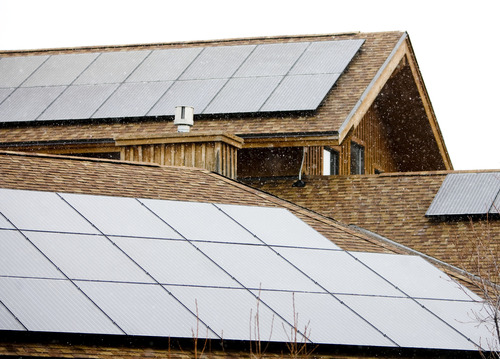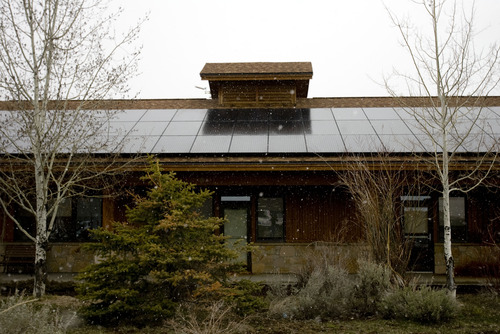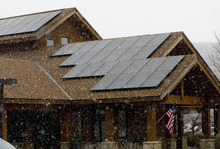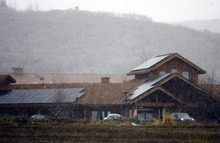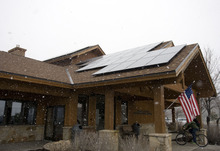This is an archived article that was published on sltrib.com in 2013, and information in the article may be outdated. It is provided only for personal research purposes and may not be reprinted.
For well over a decade, Rocky Mountain Power's Blue Sky program has offered Utahns a way to participate in the green energy revolution by buying electricity produced from wind farms, solar power arrays and geothermal plants.
But now, one of the state's leading environmental groups says it is time for the power company to start thinking above and beyond Blue Sky.
Instead of buying most of its renewable energy from projects in other states, the environmental group HEAL Utah says the power company should begin thinking about delivering increasing amounts of cleaner and greener power to its customers from projects In Utah.
"When you come right down to it, Blue Sky is a thin layer of green frosting on what is still a very dirty (energy) cake," said Christopher Thomas, executive director at HEAL Utah. "The percentage of the utility's power that comes from renewable resources has barely budged since the program began" in 2000.
And here, he argues, is the rub. Rocky Mountain Power's parent company, PacifiCorp, has indicated it doesn't plan to develop any utility-scale renewable-energy projects in Utah or anywhere else until at least 2024. Instead it plans to fulfill its green obligations by buying "renewable energy credits" from other companies. Such government-sanctioned credits represent the environmental goodwill that a utility can earn when electricity is generated at renewable-energy plants, even if the energy is not actually generated in-state.
For its part, while acknowledging that it doesn't anticipate a need for building any new conventional or renewable-energy projects for 10 years, the utility says criticism of it and Blue Sky is misplaced. But Thomas presses the point when he says that "we don't think that is what consumers want. We think consumers generally want to see more renewable-energy projects developed, even if it does cost more money in the short term."
To that end, HEAL is launching a "True Blue Sky" campaign at http://www.truebluesky.org that Thomas said will be directed at educating Utahns families and businesses about the sources of the electricity Rocky Mountain Power provides.
Today, more than 35,000 Utahns participate in the Blue Sky program, as do more than 800 businesses and nonprofit organizations in the state.
Under Blue Sky, consumers pay a premium on their monthly bills — $1.95 for each 100 kilowatt-hour block of Blue Sky energy they buy —- so they can be assured that they are supporting the production of electricity from renewable resources. When a customer commits to buying a block of Blue Sky power, Rocky Mountain Power promises a similar quantity of electricity generated from wind farms or other renewable sources will be put onto the regional distribution grid.
Since 2006, Rocky Mountain Power also has used part of the money generated by the program to assist the development of community-based renewable energy projects, primarily small solar power systems. Last year, it provided nearly $1.8 million to fund 20 projects in Utah.
Jeff Hymas, a spokesman for Rocky Mountain Power, said that "is only a small part of the renewable-energy initiatives that we have committed to over the years," pointing to company data that indicates in 2004 the utility generated 68 percent of its power from coal-fired plants, while today 60 percent of its electricity comes from burning that fuel.
Eight percent of the electricity delivered to Rocky Mountain's customers comes from wind farms, compared with less than one-half of one percent a decade ago, according to the utility's data.
Blue Sky does support some renewable-energy projects, Thomas said, but most of the commercial-sized projects are out of state, and the small-scale projects the program encourages produce a miniscule amount of power, compared with the company's overall energy production.
"It's time for them to come up with something better — a program that allows customers who want green energy to invest a percentage of their monthly electric bills into renewable-energy projects here in Utah."
Hymas counters that PacifiCorp, which does business in Utah as Rocky Mountain Power, is the second-largest regulated utility owner of wind resources in the country. "Regardless of where our generating facilities are located, they benefit all of our customers. Most of our wind facilities are in Wyoming because that state has good wind resources."
He added that in the past eight years, the company has constructed 12 new wind-energy facilities. "We are also purchasing more electricity from wind projects owned by others, including 100 percent of the energy generated at the Spanish Fork wind farm in Utah."
But other environmental advocates think Blue Sky could be improved and expanded.
Sarah Wright of Utah Clean Energy says a number of utilities outside of Utah offer attractive options for customers who are interested in purchasing renewable energy, initiatives that might be of use in Utah.
Wright points to Austin Energy's "GreenChoice" program, a voluntary initiative that allows ratepayers who purchase green energy to lock in prices as a hedge against the volatile and fluctuating price of fossil fuels.
Ed Clark, a spokesman for the Texas-based utility, said that when Austin Energy's customers subscribe to the program, their fuel charge, which represents the cost the utility must pay to buy natural gas and coal to generate electricity, is replaced with a green power charge that is based upon the company's contracts to buy renewable energy — primarily wind power.
"While the conventional fuel charge is adjusted at least annually, we offer our GreenChoice customers locked-in prices for terms of five, 10 and 15 years, depending on the wind contract," he said, indicating that the cost has been extremely popular with the utility's business customers.
Austin Energy also allows its customers to buy energy from large wind farms built in their home state, Thomas said.
Utahns who participate in the Blue Sky program have no way of knowing where the green energy they purchase is produced. Still, that hasn't stopped more than 35,000 of them and more than 800 companies, including the Salt Lake City plant operated by Varian Medical Systems, from signing up.
About 15 years ago, Varian, which produces tubes and digital detectors for X-ray imaging for medical, scientific, and industrial applications, started seeking ways to conserve energy. "At the time it was a very self-centered effort, we were looking for cost savings," said Doug Carlisle, facilities manager in Salt Lake City.
Yet that effort led Varian to take advantage of Rocky Mountain Power programs to help it reduce energy consumption. And that resulted in Varian, which employs about 700 Utahns, to decide to use some of its savings to invest in Blue Sky energy. Today, about 10 percent of the power used by the Varian plant in Salt Lake City is purchased under the program.
Carlisle said Varian got involved with Blue Sky because it "was interested in doing its share and giving back to the community." He thinks the challenge the utility faces is to increase awareness of the program through ramped up marketing efforts.
For Thomas at HEAL Utah, such views support research that has indicated Utahns want more renewable energy if they are presented a viable plan.
"One 2011 survey found that 53 percent of Utahns said they would be willing to pay $10 more per month to increase the share of energy coming from renewable energy projects," he said. A poll in 2007 found that 85 percent of Utahns thought the idea of switching to renewable energy was a good idea.
Thomas emphasized that HEAL doesn't think Utahns should stop buying Blue Sky energy. "The money raised supports nice projects," he said. "We just think Utahns (by participating in the Blue Sky program) are sending Rocky Mountain Power a strong signal that they want more clean, green energy. And we want them to give it to us."
Blue Sky project funding
Since 2006, Rocky Mountain Power has used part of the money generated by its Blue Sky program to assist the development of community-based renewable energy projects, primarily small solar-power systems.
Year Projects Funding Level
2006 7 $448,032
2007 9 $426,000
2008 12 $781,824
2009 13 $797,640
2010 9 $757,460
2011 12 $1,116,598
2012 20 $1,795,820
Total 82 $6,123,374
Source: Rocky Mountain Power




